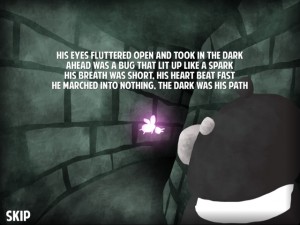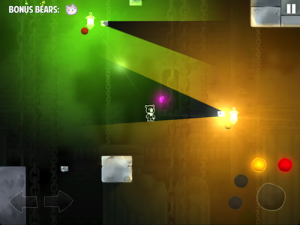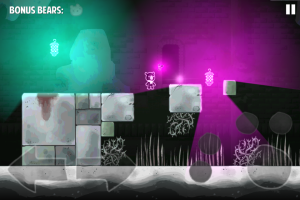There seems to be a recent trend for indie developers to create a game with dark imagery – filled with half constructed sentences that seem to allude to a deeper meaning, but probably didn’t ever actually mean anything at all – just to obscure the fact that they didn’t know how to make a fun platforming title, with working controls and/or jumping physics, to begin with. Thankfully, for Taco Graveyard’s recently released Penumbear (out now, $1.99), this game – despite its initially dark looking trappings that might lead some to believe it’s just another one of those brooding art titles – is a straight up platformer through and through. Here you’ll be dealing with 100 levels of puzzle based jumping gameplay – as well as the occasional gigantic boss encounter – rather than suffering through bad controls, all while wondering if even the programmer himself ever understood any of the words he wrote.
 The first thing I am going say about Penumbear is that Taco Graveyard definitely made sure they got the most important part of any jumping based game correct: the accuracy of the controls. This might seem obvious, but some of you would be surprised by just how many platforming games on the iOS have controls that are woefully inadequate for controlling the on screen action. The basic controls for Penumbear consists of left and right movement buttons on the left hand side of the screen, and a giant jump button present on the opposite side of the device.
The first thing I am going say about Penumbear is that Taco Graveyard definitely made sure they got the most important part of any jumping based game correct: the accuracy of the controls. This might seem obvious, but some of you would be surprised by just how many platforming games on the iOS have controls that are woefully inadequate for controlling the on screen action. The basic controls for Penumbear consists of left and right movement buttons on the left hand side of the screen, and a giant jump button present on the opposite side of the device.
The first of the various common control pitfalls that Penumbear’s buttons manage to avoid is that they don’t ever run into the touchy issue many iOS games have where you can press the designated on screen area without anything happening at all, or – even worse – having some other button trigger entirely. This degree of accuracy is especially important since Penumbear will often call upon players to double tap for a running start before they execute a leap, and there will be many occasions where this feat will have to be performed from on top of the tiniest of platforms. The game will also give players the ability to perform a double leap by tapping the jump button twice in a row, and will even curiously let the player initiate the first of their two jumps while they are falling down through thin air (something very uncommon in a platforming game).
 The other controls in the game are the four context sensitive light buttons, arranged in a semi-circle around the jump button, that can be used to trigger any switches near enough to be pinged by the lightning bug following our stoicly stuffed hero. It is when any of these lights are on that the ability, after which the valiant teddy bear was named for, comes prominently into play: the hero’s ability to physically stand on the hard edges where light and shadow touch. Furthermore, the castle through which the hero must explore features a variety of platforms that only solidify either when they are or aren’t being touched by one of the various colorful lights.
The other controls in the game are the four context sensitive light buttons, arranged in a semi-circle around the jump button, that can be used to trigger any switches near enough to be pinged by the lightning bug following our stoicly stuffed hero. It is when any of these lights are on that the ability, after which the valiant teddy bear was named for, comes prominently into play: the hero’s ability to physically stand on the hard edges where light and shadow touch. Furthermore, the castle through which the hero must explore features a variety of platforms that only solidify either when they are or aren’t being touched by one of the various colorful lights.
Using the hero’s run and double-jump skills, as well as the bear’s abilities to traverse the penumbra, the player will lead the game’s protagonist to an escape door at the end of each of the title’s 100 varied levels. Of course not every door will be as simple to open as just walking up to it, sometimes the titular Penumbear will have to seek out and collect a specified number of key-fireflies before the portal will open. Thankfully, especially in regards to some of the longer levels, the game seems to checkpoint the player’s progress each and every time they collect one of these glowing insects of unlocking.
 What isn’t preserved by any of Penumbear’s checkpoint moments is the progress made towards the collection of special hidden bears that the player is tasked with optionally seeking out. This is rather frustrating as many stages feature more than one hidden bear, and – furthermore – will often hide them on tricky to reach platforms that require a precise double-jump leap of faith across an otherwise empty abyss. It just doesn’t seem fair in the slightest that other parts of a player’s progress are being preserved when a checkpoint occurs, and so backtracking over and over again to pick up bears you already safely grabbed quickly turns into frustrating tedium.
What isn’t preserved by any of Penumbear’s checkpoint moments is the progress made towards the collection of special hidden bears that the player is tasked with optionally seeking out. This is rather frustrating as many stages feature more than one hidden bear, and – furthermore – will often hide them on tricky to reach platforms that require a precise double-jump leap of faith across an otherwise empty abyss. It just doesn’t seem fair in the slightest that other parts of a player’s progress are being preserved when a checkpoint occurs, and so backtracking over and over again to pick up bears you already safely grabbed quickly turns into frustrating tedium.
Anyways – matters of non-checkpointed bears aside – Penumbear does feature a staggering 100 levels for players to search through, a sizable amount which should keep many busy for quite some time. Furthermore, these levels feature an ever increasing number of tricks – as well as novel new arrangements of elements – to throw at players such that the game never starts feeling like any one area is merely a more annoying rehash of an earlier stage. Of course there are also the aforementioned hidden bears which – should a player not find them annoying – add even more gameplay time on top of the main escape quest, making this particular teddy bear’s adventure a particularly heavy weight package.
The game itself features a decidedly dark and moody presentation – which perfectly compliments the main character’s ability to walk on the lines where light and shadow come together – while also being cartoony at the same time, a fact which otherwise helps to temper the more somber nature of Penumbear’s setting. An aspect of the game’s appearance that was particularly eerie for me were the cthulhuesque tentacles that reach up strainingly from the bottom of the castle’s basement, always pointing in the hero’s direction whenever he strays too close to the bottom. Meanwhile – on the more whimsical side of things – there is the voice of the game’s hero, which has been geared to – rather appropriately – sound a lot like that of a young child (especially when he triumphantly laughs after picking up a hidden bear).
iFanzine Verdict: Penumbear provides a lot of content – solid jumping controls – and a unique mechanic where the hero is able to walk on the lines where light and shadow come together, all of this making it a heavy weight contender amongst iOS platforming games. It furthermore features a well executed art style that perfectly compliments the light and dark themes of the game’s main mechanic, without becoming overly depressing in the process (but perhaps not enough for those who prefer their games to feature blue skies). Finally, the game’s hidden bear mechanic – while potentially adding even more play time to Penumbear’s already staggering amount of content – can just as easily drive players bonkers due to how the mid-level checkpoint system ignores any progress made upon this particular front.


